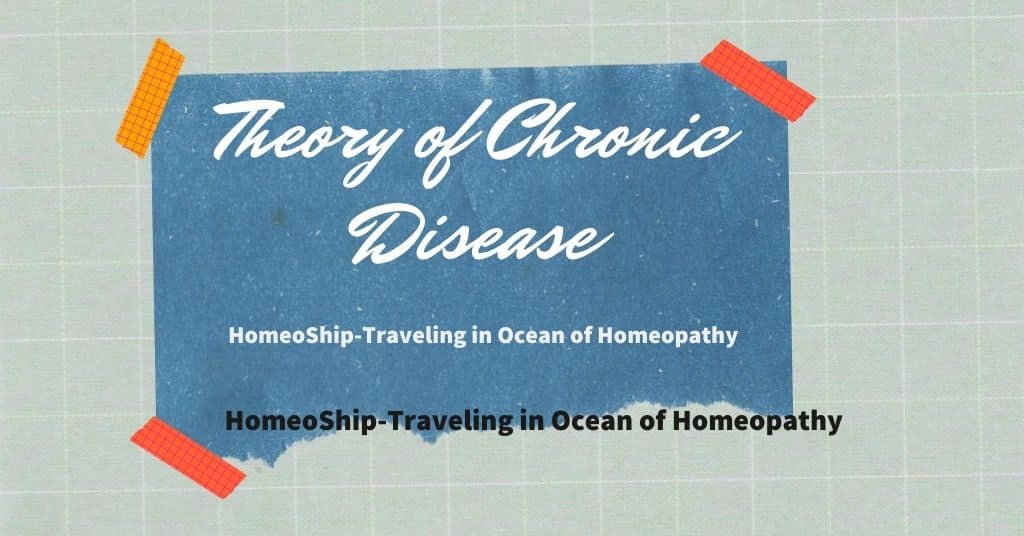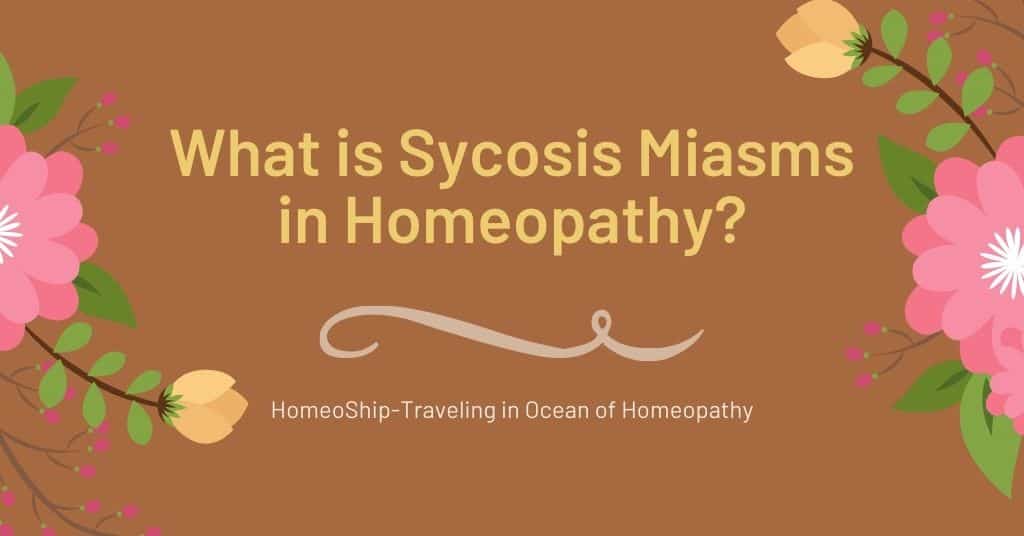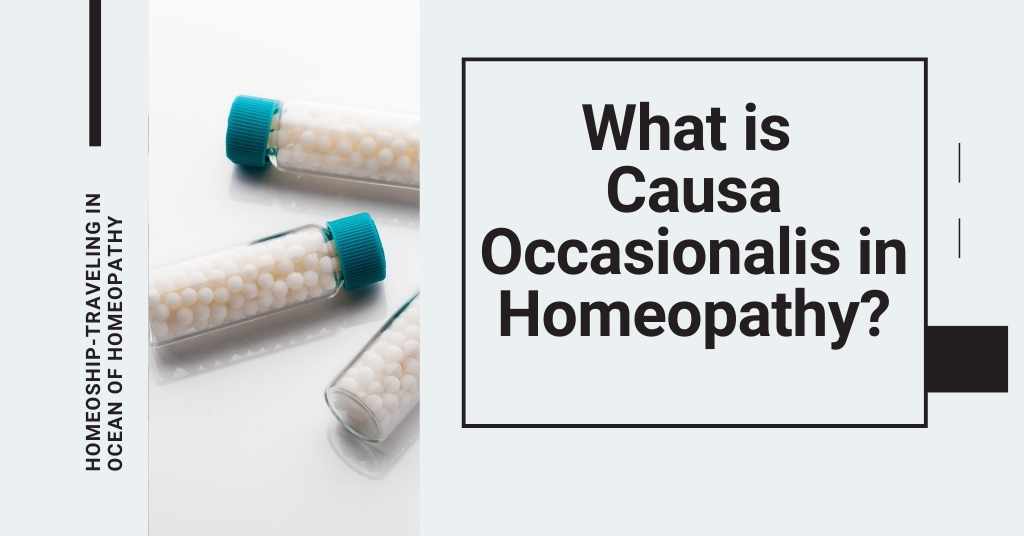Contents
The theory of chronic disease was first introduced into the 4th edition of Organon of Medicine in the year 1829. This theory is known as a result of Hahnemann’s practical and clinical experience and not an overnight fancy.
He states in the footnote to § 80 “I have spent around 12 years in investigating the source of the chronic diseases, based on the ascertained proofs”. In his “Chronic diseases”, Hahnemann states that since 1816 -1817, he was involved in finding out the cause of chronic diseases. But he did not reveal this to the homeopathic world, because the task was unfinished and incomplete.

Further, in the footnote, he clarifies that his efforts of finding the cause of chronic disease were revealed to two of his disciples (Dr.Gross and Dr.Stapff). He finally concluded that the cause of all the chronic diseases is the multi-headed monster Psora.
Before the discovery of this theory, all homeopaths including Hahnemann treated each and every disease as an idiopathic disease, purely based on the totality of symptoms alone. But the discovery of the theory of chronic diseases revolutionized the treatment of chronic diseases in homeopathy.
Hahnemann recommended that all homeopaths should read his observations on this subject in his original book “The Chronic diseases its cause and cure” published in the year 1828. The essence of the same book was incorporated into the consecutive editions of Organon of medicine.
Therapeutic Importance of Chronic Miasmatic Theory
The theory of Psora has given a theoretical explanation to the fundamental cause of the diseases to the world. But most of the homeopaths say, “What is the practical importance of chronic miasmatic theory and miasms, as long as a homeopath strictly selects a similar remedy to the patient based on symptoms similarity alone?”
Dr. J.H.Allen, in his “Chronic miasms” gives the answer, “The fact is, we cannot select the most similar remedy possible, unless we understand’ the phenomenon of the acting and basic miasms; for the true similia is always based on the existing basic miasms, whether we be conscious or unconscious of the fact”. “It is like intelligent warfare and fighting in the dark”.
In short, the qualitative totality of the patient is the miasmatic state of the patient. Dr. H.A.Roberts says, “The miasms are destructive in every way, of both the mind and the body, and they tear at every spirit of man, it is disorganizing disease that fills the state institutions of every description and we cannot meet these conditions intelligently until we recognize the ancient origin of disease and undertake its examination on the basis of miasms”.
Even Hahnemann in the 5th aphorism of 6th edition says, “Useful to the physician in assisting him to cure are the particulars of the most probable exciting cause of acute disease, as also the most significant points in the whole history of chronic diseases, to enable him to discover its fundamental cause, which is generally due to chronic miasm”.
Phyllis Speight in the introduction to her book, “A comparison of the chronic miasms” says “It is unfortunate that the miasms are to a great degree ignored today and this brings homeopathy into disrepute; I have had demonstration that in order to cure, it is essential to consider these miasms, as these are the basic cause of chronic disease”. Selecting similimum is the work of a homeopath.
But the selected similimum must be similar to the miasmatic state of the patient which is the cause of all his sickness. Constructing the totality is the construction of the miasmatic state of the patient. This is true “cessat effectus cessat causa”. Hence knowledge of chronic miasmatic theory is mandatory for a homeopath; it has become one of the fundamental principles of homeopathy.
Nature of Chronic Diseases
Homeopathic healing art has shown its superiority in treating both the acute diseases of epidemic and sporadic types. Venereal diseases were also effectively controlled by this system of medicine, but controlling the non-venereal diseases remained a problem to most homeopaths all over the world before the discovery of the chronic diseases. Allopathic nonhealing art, by their violent methods, has not only aggravated the diseased condition but also contributed to the development of the nameless chronic diseases in this world. It is not so with homeopathy, the great gift of God.
The cure in homeopathy is done without robbing the patient of his vital fluids and strength but based on symptom similarity. Some errors in diet, taking cold, the appearance of rough weather, wet, cold, stormy, autumn and winter, the violent exertion of body or mind, a shock to health, due to external injury, or any sad event that depressed the soul, repeated fright, greater grief, sorrow, continuous vexation, often cause weakness of the body.
This results in the reappearance of the disease which was controlled previously. When such recurrence was noticed, the homeopathic physicians treated every recurrence with the most similimum remedy in the materia medica. This relieved the patient temporarily but the disease would reappear once again.
Some joyous occurrence, or an external condition of circumstances, improved by fortune, a pleasant journey, a favorable season, or a dry uniform temperature, would produce a longer or shorter relief to the patient. When such conditions would vanish, the complaints would recur in spite of the best selected homeopathic remedy.
The chronic disease could, despite all efforts, be but little delayed in its progress by the homeopathic physician and grew worse from year to year. In the Chronic diseases, their beginning was promising, continuation less favorable and outcome hopeless. This was the problem faced by the homeopaths of Hahnemannian time before the discovery of the theory of chronic diseases.
Discovery of Hahnemann’s Theory of Chronic Diseases
Practicing homeopathy for 30 years (1790-1820 A.D.) and preaching homeopathy for 18 years (1810-1828 A.D.), Hahnemann observed that acute diseases were successfully treated by homeopathic medicines, but chronic diseases were not controlled by the homeopathic medicines. Despite all efforts, these chronic diseases grew worse from year to year. In spite of treating all these diseases in exact accordance with the homeopathic principles, they still remained uncured. Their beginning was promising, continuation less favorable and outcome hopeless.
“The non-venereal chronic disease of psoric origin, after being time and again removed homeopathically by remedies fully proved up to the present time, always returned in more or less varied form with new symptoms, reappeared annually, with an increase of symptoms,” says Hahnemann.
Hahnemann suspected one of the following reasons to be the cause for the failure of the homeopathic treatment in chronic diseases:
1. The law of similia might not be the law of universal application
2. The number of homeopathic medicines discovered so far were too few to cover the variety of disease conditions
3. There may be some defect in the application of the law of similia.
4. There may be some defect in the collection of the totality of symptoms for homeopathic treatment
5. There be some obstacles overlooked, which prevented the long-lasting cure.
Must Read:
- What is the Happy Go Lucky Operation in Homeopathy?
- What is Genus Epidemicus in Homeopathy?
- What is the Brousseauic/Brousseau method of treatment?
- Hahnemann logically and practically answered his questions in the following manner:
Reason no. 1: The law of similia is based on exact observation, correct interpretation, rational explanation, and scientific construction. This is perfectly supported by the inductive method reasoning. This law is nature’s law. The therapeutic law of nature was even supported by ancient physicians all over the world. This law of nature was well known to the physicians of ancient times.
The father of medicine Hippocrates, physicians like Nicander, Xenocrates, Varro, Quintus, Serenus, Paracelsus, and physicians of Roman schools, Basil Valentine, Benedictine monk of Erfurt, Hindu Ayurvedic sages, etc mentioned the possibilities of curing diseases by the law of similaris.
They could not employ this law universally because of its limitations. Hahnemann successfully molded it and applied it in curing diseases by changing the law from “similia similibus curanter” to “similia similibus curentur” i.e. “like cures like” was changed to “let likes be cured by likes”. So, this cannot be termed as the reason for the failure of treating chronic diseases as we cannot suspect the efficacy of nature.
Reason no. 2: The reason for the fewer number of homeopathic remedies is also practically not applicable because the ever-increasing number of new homeopathic remedies introduced into the materia medica did not improve the cure of non-venereal diseases a bit. But the acute and the venereal disease were effectively controlled by the existing and newly added remedies.
Reason no. 3 & 4: The repeated failure to treat chronic diseases gave Hahnemann a clue that the disease picture may not be just those symptoms that the patient presents to the physician before him at the time of consultation. But, the physician has to enquire about the deep-seated original disease in order to cure the diseases not only speedily but also permanently.
The homeopathic physician, “Therefore must first find out as fast as possible, the whole extent of all accidents and symptoms belonging to the unknown primitive malady, before he hope to discover one or more medicines”. So the defect was found in ascertaining the totality of symptoms. So, in chronic diseases, the totality is not limited to the presenting complaints alone but also through inquiry of the past history of the patient as well.
The technique of collecting the totality of chronic disease is explained in § 83-104 of the Organon. Further in § 5, Hahnemann explains “In these investigations, the ascertainable physical constitution of the patient, his moral intellectual character, his occupation, mode of living, and habits, his social and domestic relations, his age, sexual functions etc are to be taken into consideration”.
Reason no. 5: Last but not the least, is the doubt of some obstacle in the recovery which might have been overlooked previously. Hahnemann called these major obstacles as the miasms. It can never be removed by the strength of robust constitutions, the most wholesome diet, and the order of life. This obstacle does not die out of itself but aggravates even more year after year if left untreated.
After prolonged investigations and observations, Hahnemann discovered that in most of the cases this obstacle dated back to the former eruption of itch. Every patient’s suffering was dated back to that time. The suppression of itch by the violent allopathic medication was clearly followed by the development of new symptoms. This fact was not only found by Hahnemann, but also by other physicians of his times and his seniors.
Hahnemann gave a general name to this obstacle retarding cure and defined the manifestation of this obstacle, in the form of symptom syndrome. The symptoms produced by this obstacle, when the skin eruptions are still fresh and after the suppression of the skin eruptions by the violent allopathic procedures, were named by Hahnemann by the general name called “Psora”.
“Gradually I discovered more effective means against this original malady that caused so many complaints against this malady, which may be called by the general name-Psora. i.e. against the internal itch disease with or without its attended eruption on the skin” concludes Hahnemann.
Thus Hahnemann came to a conclusion that the major obstacle and the cause of the failure of homeopathic medicines in curing chronic diseases are the miasms. Complete cure is only possible by fully eradicating these miasms from the organism and understanding them properly. To understand the miasmatic basis of the disease inquiry of the personal history, treatment history to find any suppressions, etc, the genetic history or the family history of a patient is very essential. “Gradually I discovered the more effective means against this original malady that caused so many complaints, against this malady which may be called by the general name psora i.e. against the internal itch disease with or without its attended eruption on the skin,” says Hahnemann. He regarded psora as the most fundamental among all these miasms. “I was thus instructed by continued observations…. That the ailments and infirmities of the body and the soul, which in their manifest complaints do not belong to the two venereal disease, syphilis, and sycosis, but partial manifestations of the ancient miasms of leprosy and itch”. That is, psora alone is the cause for all the diseases.


